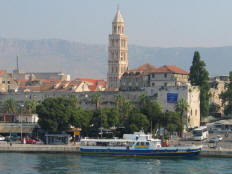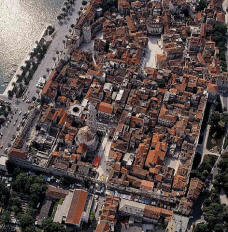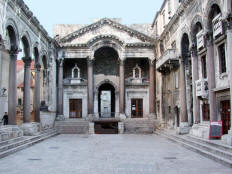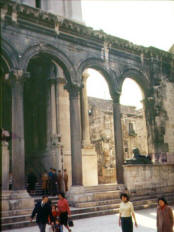Monday, 12 April. After breakfast we drove the few blocks to Diocletian’s Palace
(305 A.D.), arriving about
09:30. At first we didn’t even see the Palace although it was right in front of us.
After the Palace
was abandoned, the Roman inhabitants of nearby Salona, seeking refuge from
invading Slavs, fled to the Palace and converted it to homes and shops, often building walls
between columns and otherwise enclosing open spaces. We finally realized that most
of the old
edifices we were facing were neatly separated by regularly spaced Roman columns; the seeming
jumble of separate structures was really the Palace! All we had to do was to find a way in.

We suddenly discover the Palace facade |

Another view of the Palace facade |

Tour boat in front of the Palace |
This scale model (looking south) and aerial view (looking north)
are really helpful in understanding the layout of the Palace.
Unfortunately, we didn't have them at the time.

Scale model of Diocletian's Palace |

Aerial view of Diocletian's Palace |
We entered through the southern gate (Porta Aenea) at the lower level and emerged at the
Peristyle (courtyard surrounded by columns). As we were looking at the Cathedral (former mausoleum), we picked up a “volunteer”
guide who insisted on showing us the Cathedral, Baptistry (Jove’s Temple), and Peristyle. After
giving our guide a small tip, we wandered around the Palace on our own, going out the north gate (Porta Aurea), then back in and out of the west gate (Porta Ferrea). We walked around the north end of
the Palace, then back in and toward the lower level where the boys had a ball running around and
hiding from each other.

Statue (John the Baptist) in Baptistry |

The Peristyle |

Onyx lion along Peristyle |
Afterward we bought some things for lunch and ate them in the market place east of the Palace.
Then we browsed the shops and bought a few carved walnut items ( a flute, a plate, and a small
spinning wheel). Larry and Dennis (our older boys) had already walked back to the hotel for a
swim, and we got the car and dropped Randall and Kevin there, too.
Then the two of us drove out to Solin to see the ruins of ancient Salona. We expected to find it
swarming with tourists, but it was completely deserted. In the total silence, the ruins were all the
more impressive. Even so, as we walked the ancient lanes, a man came running from nowhere and
collected the three dinar (20 cents) entrance fee.
Salona, just three miles from modern Split, was a thriving Roman colony and the
capital of Illyricum in the first century B.C. Titus, the pupil of St.
Paul, preached here, and this is where the first Christian martyrs were killed.
When Emperor
Diocletian retired in 305 A.D., he built a magnificent palace nearby. In
639 Salona was destroyed by invading Slavs, and its residents
fled to Diocletian's
Palace, which became the city of Spalato, now Split.
Salona had been completely destroyed with nothing left standing, but work was underway to
rebuild some of the walls on the original foundations. The large amphitheater was furthest along
and most impressive. We were also treated to the sight of a man riding through the ruins on a
small donkey, his feet nearly dragging on the ground.

Partially restored ruins in Solin |

Darrell at old Roman fountain |

Salona's Roman amphitheater |
On the way back into Split, we stopped at a department store and browsed through it. We bought
a couple bottles of maraschino liqueur (from Zadar) at 22 dinars ($1.45) each. On reaching the
hotel, we discovered that the boys had not been able to swim because dirty seawater had
accidentally been
pumped into the pool and it was covered with an oil slick. Again, we ate at the hotel, visited the
casino for a while, and went to bed.
Page 1
2
3
4
5
6
7
8
9
10
11
[public_html/Travels/borderbottom.htm]